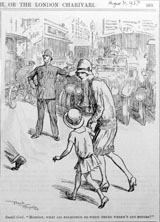Introduction
What is public order? This is not a question that is easy to answer. In a sense you might respond by saying that 'public order' is essentially the absence of disorder – the quiet and orderly behaviour of people in public space. It involves people behaving sensibly and rationally, and respecting others. The problem is that one person's exuberance on the street often constitutes an annoyance to another. Then there are problems of nuisances in the form of obstructions on a street or a roadway, or dangerous dogs, possibly even a runaway horse. The old time parish constables had to present offenders before magistrates for 'nuisance' and they prosecuted people for riding horses, or driving carriages, carts and wagons dangerously. The new police continued these old practices, but given their numbers and their central direction they were able to enforce new levels of decorum on the streets and this, some historians have argued, became one of their key duties in the years following their creation.
The police are often regarded as, primarily, crime fighters. But police officers take an oath to maintain the sovereign's peace, and maintaining the peace can be equated with maintaining 'public order'.
Objectives
At the end of this module you should have some understanding of:
- The range of problems that can be encapsulated by the term 'public order';
- The difficulties that have been faced by the police in the maintenance of public order;
- The discretion that might be needed by the police in such circumstances.
 "Mother, what did policemen do when there weren't any motors?"
"Mother, what did policemen do when there weren't any motors?"